Where: The photo was taken along Gap Road, now the eastern end of Queen's Road East. The identifying landmark is the building in the background:
That was the Royal Naval Hospital, near where the Ruttonjee Hospital is today.
When: The road got its original name, Gap Road, from the cutting it passed through between Wanchai and Happy Valley. Here the right (north) side of the cutting has gone - there's just a piece of rough, flat land in its place. That used to be Morrison Hill, but it was dug away in the 1920s, and used to reclaim land off Wanchai.
I'll guess this was taken soon after the reclamation, around 1930.
Who: A large group of soldiers:
Can you see any clues in their uniforms that tell us more about these men?
What: The black armbands indicate this is a funeral procession, heading to one of the cemeteries in Happy Valley.
Reference: EC031A
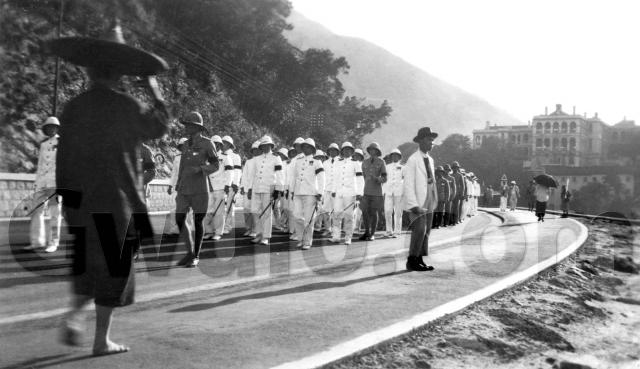
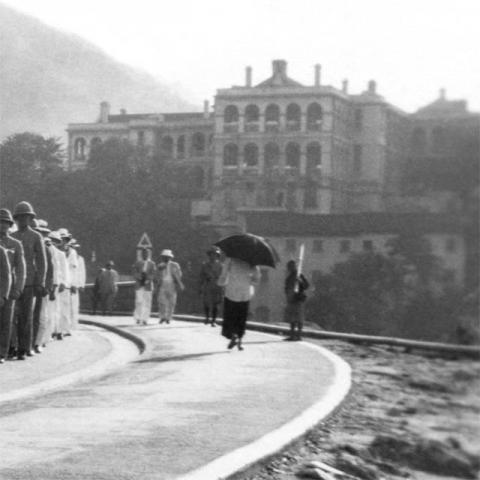
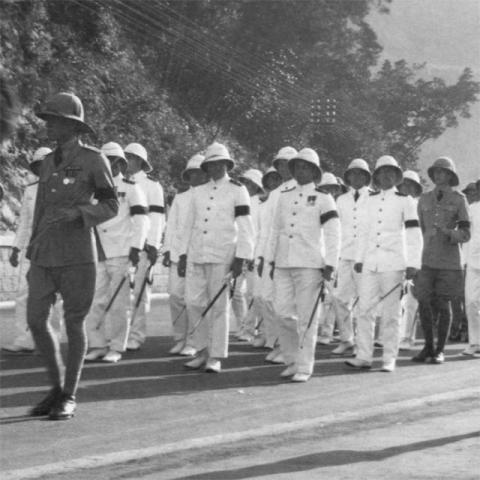

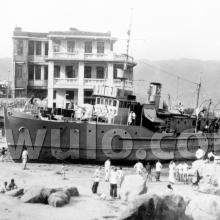
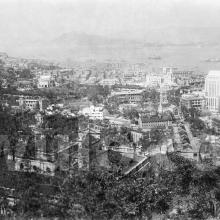

Comments
Cemetery entrance off Lower Stubbs Road
David welcome back from SG, and sorry your investigations were not more fruitful...
However its still a fine City, and they certainly have shown greater pride and initiative in looking after the historical quarters and buildings than we ever seem inclined here in HK.
Regarding the above photograph, looking at the orientation and distance of the Royal Seamans Hospital and the bending road, I am just wondering if the procession was heading up Lower Stubbs Road and planning to use the upper entrance to the cemetery?
Would that have been usual practice for burials on the upper terraces?
Would military funerals have taken a different route than civilian ones?
As an aside, I recall from forgotten souls there was an obelisk and meeting point somewhere near Wanchai market area that people would gather to pay their respects to the passing cortege, if they did not plan to attend the graveside.
The telegraph wires behind the soldiers might help pin down the date too.
Can anyone identify the regiment?
Regards
Julian
Thanks Julian, I enjoy seeing
Thanks Julian, I enjoy seeing all the old buildings in Singapore. Maybe we should start a Singapore branch of Gwulo.com!
I don't think they're as far along as Stubbs Road. Once you start up there, the hospital would be hidden by the hillside. I'd put the Stubbs Road junction just out of sight to the left of the photo.
The obelisk near Wanchai market sounds like the Kuhlan Monument: http://gwulo.com/node/7208
Regards, David
Yes David I am inclined to
Yes David I am inclined to agree with you on reflection - I was mistaking the end wing of the hospital in the background, for the front facade - which is symmetrical unlike the photo.
A quick look at the Hal Empson charts put me right.
Actually according to the older maps, to the front of the Royal Seamans Hospital, and overlooking (the then) waterfront in the 1920's was the Lord Chief Justice residence.
I dont know if we have a picture of that building anywhere on the site, but it must have been a fairly grand building by the standards of the time, and it would be interesting to get a look at.
It had a commanding view of the harbour, perhaps akin to the Old bela Vista Hotel in Macao.
Finally went to an interesting talk by Jason Wordie on the history of construction in Hong Kong last tuesday evening.
Fascinating stuff.
One little point of interest, (among the many), was the fact that when trade was slack and the cargo volumes small, the postal steamers coming out of England, who had to sail anyway, would bring London red clay bricks to HK to act as ballast in the empty holds.
These were later incorporated into such buildings as HK University, Kowloon Station Clock Tower and some of the old public buildings and residences we see dotted around today...
best rgds
Julian
re: c.1930 Funeral procession along Gap Road
Hi Julian, interesting source of the red bricks - hadn't heard that one before!
Here's all we've got about the Chief Justice's residence (not much): http://gwulo.com/node/8225
Barbara Anslow wrote:
I can't help in finding out who the mourners are in the photo, but I instantly recognised the Naval Hospital, as in 1928/9 we lived very near it, at 96 Kennedy Road which was an old terraced building let out in flats. I had a friend my own age called Beryl Olver whose father worked in the Naval Hospital. She was then about 8, and told me she had tried to take some of her little friends to the mortuary there to view the corpses!
When we returned to Hong Kong in 1938, I visited the Naval Hospital when my Dad became ill and spent some days there.
You suggest that Morrison Hill was demolished in the 1920's... but it was very much there in 1929 when the twice-daily blasting really intrigued us, watching for the puffs of smoke and the scattering of pieces of granite. I used to climb up and over M. Hill to visit one of my friends who lived the other side.
M Hill was still very much there (though not so much of it) up to 1941, when we were then living opposite in Gap Road. I'm sure it was there at least up to when we retired in 1959.
Barbara's right, although the bulk of the hill was gone by the time the reclamation was finished, there was still a good chunk of hill left at the eastern end. It took a long time for them to completely remove it. You can still see a small piece remaining in this 1950s photo: http://gwulo.com/node/8510
Bill Griffiths comments on the soldiers:
Those in white uniforms all appear to be Officers...carrying swords...and It is interesting to note that the two officers in Khaki and puttees both have Pilots Wings on their left breast...and are carrying canes rather than swords...
I don't know what this implies...but I will keep looking...
Could this be some sort of memorial service parade???
I hadn't noticed the pilots' wings. Here's a close-up for a better view:
This is one of a small set of four photos. One other shows a group pulling a carriage, that I guess carried the coffin, and another shows a group of servicemen carrying wreaths. The last shot was taken of graves in the cemetery, though it isn't obviously a new grave.
Putting those together it seems likely to be a funeral procession heading to the cemetery.
It looks as all the different services are present. Was that standard practice, or does it indicate the funeral was of someone very senior?
Finally, Henry Ching has an interesting suggestion:
I am guessing now, but it seems to me the uniforms they are wearing are not British. Americans? Is there any possibility that it had something to do with the removal of the Kuhlan Memorial from Wanchai to Happy Valley? I think this was in the early 1930s.
When I have a moment I'll scan in the other photos from the set to see if they add anything to the story.
Regards, David
Soldiers on Gap Road
Bill Griffiths writes:
No, it was not standard practice to have such a vast amount of the different services...unless it was for a very senior officer..or perhaps a Government representative or other important person....It is baffling though because the uniforms in the pictures are not easily recognisable....and strange that some are wearing White Tropical dress...and others...khaki...and... no sign of a Cap Badge to help us out...
The Pilots wings would appear to be British...but can't be 100% about this...
It would be interesting to see the other Pictures that you refer to...
And...is there any evidence of anyone of importance in the colony dying at this time....???...
Was it definitely 1930..or thereabouts..???
All very interesting...and worthy of further detective work...
I think the uniforms are pre-WW2, and not earlier than say 1925, so it could be from any time in that range.
Henry notes:
Interesting also to speculate on where they formed up. It appears to have been a fairly large body of men. Unlikely that they marched all the way from the Victoria or Wellington Barracks. One is tempted to think they must have formed up within the Naval Hospital grounds. But that seems a strange place to assemble. If it was a funeral procession for someone who died in the hospital, surely his remains would have been removed elsewhere for preparation? And then brought back again to the hospital? I believe the normal assembly point for military funerals was in Sports Road, or on one of the sports grounds like the Football Club or the centre of the race course. Would there perhaps have been enough room at the intersection of Queen’s Road East and Wanchai Road following the removal of the Kuhlan Monument and before work began on the new Wanchai Market?
The online newspapers aren't available at the moment, but maybe they'll have some answers.
Regards, David
Agree unlikely to be
Agree unlikely to be British. Some at least of the marchers in white and khaki seem non-European. I think we are looking at a probably mainly naval contingent, including regionally recruited personnel, with foreign officers. I would go for an American (probably including US Army Air Corps)- officered contingent, including Filipinos, who served in large numbers on Asian-based US Navy ships.
Long Shadows, umbrellas?
Small point, but notice the long shadows below the men.
This may tell us something about the time of year, and time of day the photo was taken.
If the shadows are pointing Eastwards, (if we orientate ourselves off the hospital wing) and created by a low sun, then it seems like it may be late afternoon or early evening as the sun was going down in the west.
Equally we can see the local chap heading the opposite direction feels the need for an umbrella, presumably against the sunlight/ heat, since its not raining.
Summertime, early evening then?
And who might the two fellows walking up the hill alongside the cortege be I wonder? Civilians it appears, yet with that distinctive white hat?
Rgds J
Funeral procession, other photos
Here are the other three photos in the set of four.
The second photo shows soldiers pulling a carriage. On the carriage is what looks like a coffin draped with a flag:
The third isn't as sharp, but shows more servicemen, this time carrying wreaths:
And the last is taken in a cemetery. From the names and gravestone designs, I think it is St. Michael's Roman Catholic cemetery. It's not clear if that's where the burial took place (there aren't any signs of a freshly dug grave, or wreaths):
Hopefully they'll give us some more clues.
Regards, David
SS Haiching?
Here's a bit of luck - A search in the online newspapers for funeral procession happy valley in years 1920-1940 only gave one result, and there's a fair chance it's a match:
Page 2, The Hongkong Telegraph, December 10, 1929
HAICHING PIRACY VICTIM
Impressive Funeral at Happy Valley
In the waning light of evening yesterday, the Colony of Hongkong paid its last tributes to Kingsley Frank Woodward, the gallant third officer of the s.s. Haiching who lost his life protecting his ship.
The late Mr. Woodward was buried with full naval honours, and the ceremony at the graveside was attended by the leaders of the naval, military and civil life of the Colony. It was probably one of the biggest funerals Hongkong has ever seen, and showed how deeply the brutal slaying and the courage of the dead officer and his colleagues of the Haiching has affected the whole of the European population.
Thousands of people stood respectfully by the roadside as the big cortege passed by on its way to Happy Valley cemetery, reverently baring their heads as the gun carriage draped with the Union Jack passed.
Punctually at 4.30p.m., the big party of mourners who were to follow the late Mr. Woodward to his grave on the heights of Happy Valley fell in in the compound of the Navy Yard.
To the left were drawn up sailors from all the units of the fleet at present in harbour, precedence being taken by the vessels who took part in Sunday's memorable events. Behind the sailors, officers attached to the anti-piracy section stood in full dress uniform, cocked hats and swords. [...]
Regards, David
Woodward
Hi David,
Just doing some bedtime googling and I found the book Pirates Outrages: True stories of terror on the China seas by David Sellick (http://books.google.com.au/books/about/Pirate_Outrages.html?id=TW3Z51h4qBMC).
Chapter 21 (page 315ff) has a chapter on the pirate attack on the Haiching, which occurred on 8th December 1929. Inside the preview I am able to find a detailed description of the attack and the names on board, plus the slaying of 'Mr. K.A. Woodward'.
There is enough stuff on the net about the piracy of Haiching, but nothing extra about the man himself.
breskvar
Procession & Woodward
Thanks Breskvar, here's that section about the Haiching:
Also a few questions from Henry:
There is a reference to the procession assembling at the “Navy Yard” – I wonder if this was the Naval Dockyard? If so, it was a long march.
Yes, I think they'd have started from the Naval Dockyard.
The report refers to the grave being “on the heights of Happy Valley”. Woodward’s grave is in Section 16E, at the upper boundary of the cemetery near Stubbs Road. I wonder if this is what was meant by “the heights of Happy Valley”? It would have been normal to access the burial place from Stubbs Road, as earlier suggested in another post, to avoid the uphill climb.
That would have been an easier route, but it looks as though they started from the main gates down the bottom of the hill. Later in the newspaper article quoted above, there's a section:
[...] The grave which was selected as the last resting place of the late Mr. Woodward stands on the top-most tier at Happy valley. On arrival at the gates the coffin was lifted from the gun carriage by naval men, and preceded by the clergy the procession wound up the long hill to where the grave stands on a commanding eminence. [...]
Officers attached to the anti-piracy section are said to have been in full dress uniform with “cocked hats and swords”. The photo of the officers shows them in white sun helmets. Would these have been referred to as “cocked hats”?
Wikipedia has a good explanation & photos of the cocked hat - think the type of hat we associate with Napoleon: http://en.wikipedia.org/wiki/Bicorne. I don't see any in the photos above.
I think you are right that the photo of graves is of St Michael’s Cemetery, whereas Woodward was buried in the Colonial Cemetery. The photo was likely taken in passing.
I wondered if the photo was taken looking up at the terrace where Woodward was to be buried - maybe it's in the background of the photo? Just a guess though, as there isn't any sign of a group of people up there.
Regards, David
re: cemetery
I can't spot the distinctive lady with the cross grave on google maps but almost 100% certain this is the Catholic cemetery - the names I can make out are Pereira, Antonio Santos and Baptiste.
Well I'm inclined to think we
Well I'm inclined to think we may have our man in Mr Woodward. Lord rest him.
Quite near the anniversary of his passing too, which is fitting.
Great detective work by all.
Re: Funeral
The HK Daily Press on 10 DEC 1929 reported the gun carriage with coffin on top draped in the Un ion Jack was towed by bluejackets from HMS Thracian.
A photo in the HK Telegraphon 14 DEC 1929 shows this to be the case.
Funeral
I now think it likely that the contingent in white, with swords and pith helmets, is Hong Kong Police Inspectors and NCOs.
Belts?
Hi Lim-Peng,
Looking at the 1923 photo of the unveiling of the cenotaph (http://gwulo.com/node/9362), I think the police are all lined up in the background, facing towards us. They all have dark-coloured belts, and their helmets have a dark band around.
If they'd still be using the same style of uniform in 1919, it's probably some other group than police in this photo.
Regards, David
re: funeral
this hi-res 1918 photo of Sergeant Glendinning being buried shows I assume to be the police uniforms for such an occasion. They look quite different, while the 1930s photo also seems to show the cortege is led by people that aren't British - suggesting to me it was a non-Brit being buried?
http://hkclweb.hkpl.gov.hk/hkclr2/object?svc=objrtv&src=CM&itemid=AQ87MWY9NA%238I%24I8&pid=1&mime=image/jpeg
(if that doesn't work, another link here: http://www.flickr.com/photos/14458779@N07/2384086663/)
Amazing photograph 80's kid,
Amazing photograph 80's kid, you could almost be there when you zoom in on the faces!
And the details in the background - is that cricket being played at Happy Valley...
Where did you find it?
Rgds
J
Actually a trip to the Police
Actually a trip to the Police Museum on Stubbs Road/ Coombe Road might be useful - they have many of the period uniforms on display there.
re: funeral
Hi 80sKid,
I can't tell which of the photos shows the group at the head of the procession. If you look at the three photos of the procession, each one shows a gap in front of the people being photographed.
Which one do you think shows the non-British troops? I'll blow that one up for a closer view.
Regards, David
Police Uniforms
Thanks to Henry Ching for sending a couple more examples of uniforms. First is the funeral procession for those killed in the Gresson Street incident in 1918:
Second is a photo of the police reserve taken in 1917:
Re: Police Uniform
Hi there,
In the first photo the original gateway of the Saint Michael's Cemetary was clearly shown.
Best Regards,
T
Uniforms in the picture
Hello all,
Is it possible that the chaps in white in the cortege are not military at all, but Hong Kong civil servants?
The reason I ask is that they are all wearing a uniform very similar to that worn by the late Ronnie Holmes right up until the 1960's.
Just a thought.
re: Uniforms in the picture
Hi,
It's possible, as we haven't made any other firm identification yet. Though if they are carrying swords (it looks like it), I'd say they're more likely to be military men.
If you can find any other photos with a group in a similar outfit, that'd be a great help.
Regards, David
Full Navy Funeral
China Mail 4 January 1926
The funeral procession may be the one of Seaman E. Batchelor of HMS Hawkins who perished in the Hong Kong Hotel Fire whilst peforming rescue duties.
re: Full Navy Funeral
That looks like a good candidate. The report (on page 7) mentions those attending included "members of the crews of the various ships in port, members of various local Clubs and many others". That could explain the variety of uniforms in the parade.
Regards, David
re: fire
that could well make sense. Account of the fire and his injuries here:
http://trove.nla.gov.au/ndp/del/article/21016136
Re: Funeral Procession
I think the funeral procession is for the 6 seamen that were killed as a result of a depth charge explosion onboard H.M.S. Sepoy on 8 April 1930 whilst the destroyer was returning to Hong Kong. The funeral took place on 9 April 1930 and was well attended by various branches of the Services and representatives from American, French, Italian and Portuguese warships in port. The funeral procession started off from the Naval Hospital. Similar photos of the procession appeared in the Sunday Herald on 13 April 1930.
From the Royal Navy News at http://content.yudu.com/Library/A1y7sn/200112NavyNewsDec01/resources/6.htm
Re: Funeral Procession
Thanks Moddsey, that looks very likely. Here are a couple of the Sunday Herald photos for comparison:
Funeral procession for those who died from HMS Sepoy?
Although some two years after the last post, could this funeral procession be for the 6 officers who lost their lives on the depth charge explosion (accidental) in Hong Kong waters in April 1930?
I found this newspaper article from an Australian paper (advocate dated 10 April 1930) with the following digital text:
FOUR KILLED.
Explosion on H.M.S. Sepoy.
THEEE INJURED.
HONG KONG, Tuesday. - Four men
were killed and three injured as the
result of a premature explosion of a
depth charge on H.M. Destroyer Sepoy,
when the vessel was exercising outside
Hong Kong harbor this morning.
Two bodies blown from the deck
were picked up by the destroyer Stir
ling, which was in the vicinity. A gun
nor, a petty oflicer, and two able-bodied
seamen were killed, and two able-bodied
seamen and a petty officer seriously in
jured.
The vessel suffered little damage.
One Since Died.
One of the injured men has died in
a hospital at Hong Kong, while the
condition of the other two injured, who
are also in hospital, is critical. The
officer killed was Torpedo-Gunner oeid.
Two of the killed were blown overboard
by the explosion, and picked up dead
by the destroyer Sterling.
In addition, on Navel-History.net there is the following-
Tuesday, 8 April 1930
Sepoy, destroyer, depth charge explosion
BELDERSON, William, Petty Officer, J 29333, killed
DRAPER, William J A, Able Seaman, J 111460, DOW
HEYWOOD, Robert W, Able Seaman, J 110561, DOW
REDMOND-COOPER, James N, Able Seaman, J 109926, killed
REED, Leslie G, Gunner, killed
SMITH, Thomas E, Able Seaman, JX 125791, killed
However most interesting is that, currently on EBay a seller from the UK is selling off a whole bunch of photos of the explosion damage of HMS sepoy, as well as the photos of the procession which look remarkably like the procession in this discussion, with many different regiments and groups in the procession. I have no idea how to upload photos to here, so I can't be of more help however I'm confident we are heading in the right direction. Anyone care to have a look at the photos for a second opinion? (Search 'Sepoy' on EBay).
Post note: I just noted moddsey had already identified the procession a couple of months ago. Ahh. I missed that comment! Well, this is actually my first post on Gwulo and still trying to familiar myself how to navigate around and post comments / photos etc.
HMS Sepoy
Hello Stephen,
Thanks for the extra information about HMS Sepoy, and good to see you posting to the site.
Regards, David